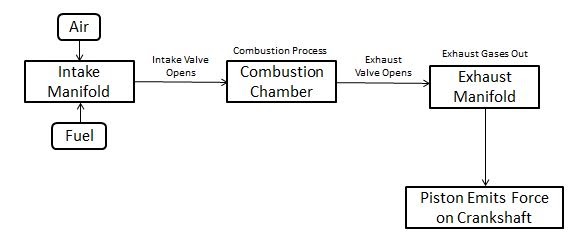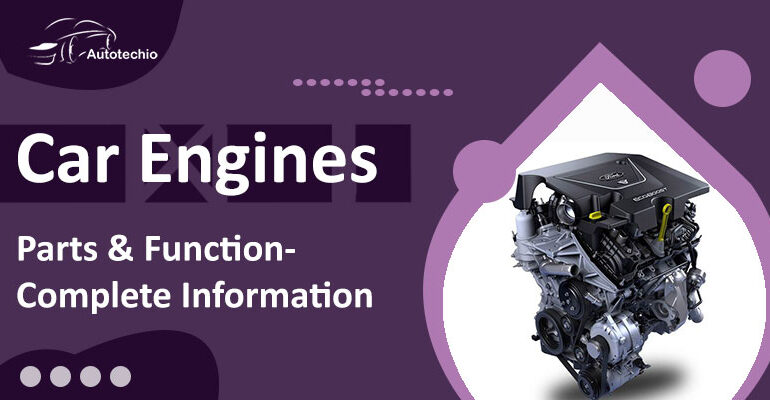Have you ever opened the hood of your car to watch the interior part and wondered what was going on in there? A car engine can look like a huge metal box with tubes and wires. In this resource, let us discuss the basic idea behind an engine and then go into detail about how all the pieces fit together. The different car engine parts & function are work to run you vehicle in easy & smooth way.
As you all know that an engine is a machine designed to convert one form of energy into mechanical energy. Heat engines will burn fuel to create the heat which is then used to do work in the vehicle. The engine has two types, one is the internal combustion and another one is the external combustion engine. Here in this article, we will share information on car engine parts & functions.
Type of car engines parts & function
There is mainly two types of engine internal & external combustion engine. Both types of engines work in different ways. Both car engine parts & functions are different.
Internal combustion engines
The internal combustion engine is those heat engines that will burn their fuel inside the engine cylinder.
External combustion engines
The external combustion engines are those heat engines that burn their fuel outside the cylinder engine.
There are different types of internal combustion engines available. Diesel engines are one type and gas turbine engines are another one. Also include HEMI engines, rotary engines, and two-stroke engines. Each has its own advantages and as well as faults.
The steam motors in good old trains and boats are the best illustration of an outer ignition motor. The energizes like coal, wood and so on in a steam motor consumes outside the motor to make steam, and the steam makes movement inside the motor. Interior ignition is significantly more productive than outside burning, and it is much more modest than a comparable outer burning motor. This clarifies why we don’t perceive any vehicles from Ford and GM with steam motors. The inspection of the engine is very compulsory when you buy a new car engine or used engine for sale. Here gets an inquiry on various car engine parts & their function.
What are the car engines parts & function
The center of the motor is the chamber, with the cylinder going all over inside the chamber. The motor depicted above has one chamber. That is common for most yard trimmers, yet most vehicles have more than one chamber (four, six and eight chambers are normal). In a multi-chamber motor, the chambers typically are organized in one of three different ways: inline, V, or level (otherwise called evenly contradicted or fighter).
Various designs have various favorable circumstances and disservices as far as perfection, fabricating cost, and shape attributes. These favorable circumstances and burdens make them more appropriate for specific vehicles. Here get an inquiry on different car engines parts & functions.
Spark plug
The flash attachment supplies the sparkle that lights the air/fuel blend so ignition can happen. The sparkle must occur at the perfect second for things to work appropriately. The spark plug is a vital car engine parts.
Valve
The admission and fumes valve open at the correct opportunity to allow in air and fuel and to let out fumes. Note that the two valves are shut during pressure and burning so the ignition chamber is fixed.
Piston
The confirmation and exhaust valves open at the right occasion to permit air and fuel and to let out vapor. Note that the two valves are closed during weight and consuming so the start chamber is fixed.
Piston rings
Cylinder rings give a sliding seal between the external edge of the cylinder and the inward edge of the chamber. Piston rings work in a very gentle way to make your engine more smooth & proper way. Here get an idea of how they work & what the role of it in car engine parts.
- They forestall the fuel/air combination and fumes in the ignition chamber from spilling into the sump during pressure and burning.
- They shield oil in the sump from spilling into the ignition territory, where it would be singed furthermore, lost.
- Most vehicles that “consume oil” and must have a quart added every 1,500 kilometers are consuming it in light of the fact that the motor is old and the rings at this point don’t seal things appropriately.
Connecting rode
The associating pole interfaces the cylinder to the driving rod. It can pivot at the two finishes so its point can change as the cylinder moves and the driving rod turns.
Crankshaft
The driving rod transforms the cylinder’s here and their movement into roundabout movement simply like a wrench on a jack-in-the-case does.
Sump
The sump encompasses the driving rod. It contains some measure of oil, which gathers in the lower part of the sump (the oil skillet)
In petroleum motors, the carburetor controls both air and fuel flexibly to the motor chamber under speed and burden conditions. They change the graceful air-fuel combination to meet the given condition. In any case, in the diesel motor, the lead representative is utilized to keep the motor speed inside cutoff points. The principle elements of a lead representative are to manage the gracefully of fuel through some instrument so the motor speed stays inside its reach.
How do car engine Parts works
The cutting edge motor is a 4-phase motor which implies it makes usable force in 4 strokes. Each stroke is characterized as the development of the cylinder from the base most position (Bottom Dead Center) to the highest position (top perfectly focused) and the other way around. The 4-strokes are as per the following: Intake Stroke, Compression Stroke, Power Stroke, Exhaust Stroke.
The burning cycle starts at the motorhead, correctly at the admission complex. The admission complex is the channel through which the air-fuel combination streams into the burning chamber. The air is straightforwardly sucked into the complex from the choke body. The fuel, then again, is infused into the finish of the complex through a spout called the fuel injector. In this image, you can see car engine parts & functions.

Next, we proceed onward to the tap controlling the fuel discharge, the valve. The valve in straightforward terms is the gadget that seals the chamber shut during ignition and opens the door when fuel needs to enter the chamber or gases need to exit. The valves open and close depending on which stroke is occurring. The opening and shutting of the valves are finished by an actuator pole known as the camshaft. These vital car engine parts offering the smooth running of your vehicle.
The camshaft is around and hollow pole with drop molded distensions known as cams. At the point when the sharp finish of the cam is turning against the valve, it pushes the valve downwards and opens up the port. When the sharp end advances back to the round end, the valve springs push back the valve to its unique position and shut the port. The turn of the camshaft is associated with the pivot of the driving rod by means of belts and pulleys. The revolution is coordinated with an exceptionally fragile and exact planning component that can be changed physically. Also, you can inspect and check all car engine parts & the functionality.
Summary
Here you get the complete information & inquiry on car engine parts & function. This will help you to get a better understanding & knowledge of the various types of car engine parts & functions. We are also sharing the information on how an engine works during the information.
I hope this article will help you to get a better understanding of various car engine parts & functions.

